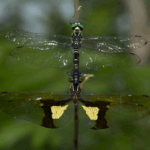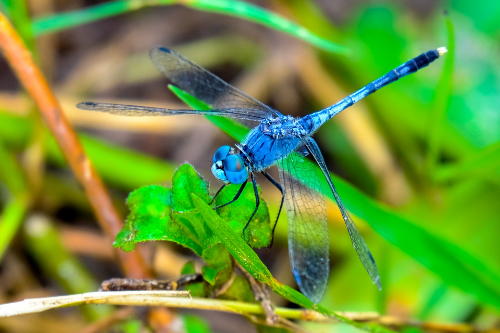
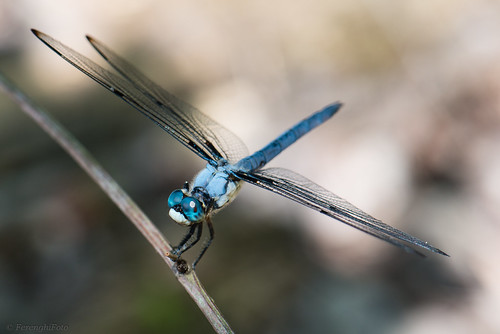
Are there any legends and myths about Dragonflies?
There are many legends and myths about dragonflies and damselflies from all parts of the world. Many are evident from their common nicknames. In the UK, Dragonflies were called ‘Horse-Stingers’. This name may come from the way a captured dragonfly curls its abdomen as if in an attempt to sting. Another possible explanation of this name is that the big Aeshnids etc. are/were often seen flying round horses in fields. Here they were actually feeding on the flies attracted to the horses. Occasionally a fly would irritate/bite a horse enough to make it twitch or skip about. People seeing it made the inference that it was the dragon, being big and obvious, stinging, rather than an unseen fly biting.
An old name for damselflies was ‘Devil’s Darning Needles’. This stems from an old myth that if you went to sleep by a stream on a summer’s day, damselflies would use their long, thin bodies to sew your eyelids shut! Naturally there is no truth in either myth
Similar myths are found throughout the world. You can find more about them by visiting Cultural Odonatology References, a site which has reference material relating to myths, legends, folklore and cultural significance of Odonata throughout the world. For more myths, and mythical names used in Europe you could visit Swedish Dragonflies where you will find a page of such items. (Both these links will open in a new window.)
Dragonflies have been the subject of many tales and myths
Many tales and myths have been imparted over the years about dragonflies. In fact, these
magnificent insects derived their name from the mythical dragon. Native Americans believed that the dragonfly was, in fact, a dragon that was tricked by a coyote to shape-shift into itspresent form of an insect. Once the dragon took the form of a dragonfly, it couldn’t shift back. Then and now the dragonfly represents swiftness, illusion and change.
Dragonflies are of the order Odonata, and are not flies at all. Worldwide, there are about 5,000 species of Odonata, which also includes damselflies. In the United States alone, there are approximately 400 species.
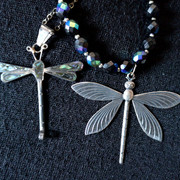
Female dragonflies lay eggs in or near lakes, streams, ponds or other wetlands. The nymphs that hatch from the eggs feed and grow underwater. These nymphs are predators and eat tadpoles,snails and insects while in this stage. They have a special appendage on their head that they use as a spear to catch prey. They are predatory insects from birth. The gills of the nymphs are located inside the abdomen. The tiny creature will expand and contract its abdomen to move water over its gills and squeeze the water out rapidly for movement.
The majority of the dragonfly’s life is spent in the larval stage in the water. It will molt many times during this time and development varies depending on altitude and latitude. This stage can be from one to six years. They are not born with wings but develop them throughout the metamorphosis process. Once the larva has completed its growth and development stage, it will leave its aquatic environment and start a brand new life as a dragonfly.
Once the dragonfly reaches adulthood, it only lives for a few weeks in which time it must mate and reproduce. Male dragonflies are very territorial. Usually when you see dragonflies chasing each other it is one male protecting his area from another. However, when you see two dragonflies flying while attached, you can be fairly certain they are mating.
Dragonflies are extremely swift in their flight, reaching speeds of up to 30 – 35 miles per hour.
They flap their wings at about 30 beats per second compared to a bee’s 300. Since they have two sets of wings, they can flap without being in unison as other types of insects do. Their back wings can be moving one way and the front another direction. The wings are mostly transparent and move very fast, so it often appears that they have more than two pairs. The front wings of the dragonfly are slightly longer than the rear wings. This helps with both speed and maneuverability. They are extremely strong fliers and can hover, fly backwards, sideways and even loop around.
Dragonflies have very large, compound eyes. They are multifaceted and they can see nearly 360 degrees around. It is said that dragonfly eyes contain up to 30,000 individual lenses. Human eyes only have one. Even though most of the insect’s brain is devoted to sight, they don’t see detail well but are attracted to movement. However, they do have a special area, directly in front of their compound eyes, that is flat and is concentrated with eye cells, which allows them to pinpoint insects as they fly.
Even though dragonflies have six legs, they cannot walk very well. They are built for flying and grab insects out of the air and eat them while in flight. They are carnivorous their entire lives and have a voracious appetite in every stage. Nymphs can actually propel through the water via an opening in their body that ejects water acting as a thrust mechanism. As adults, dragonflies can eat their own weight in insects in less than an hour. This ravenous appetite keeps mosquitoes, which are their main food source, and other insect pest populations in check.
Dragonfly trivia:
- Though many people fear them, dragonflies cause no harm to humans.
- Dragonflies will sometimes travel in swarms, which may be related to weather changes such as the passage of cold fronts.
- The largest dragonfly fossil had a wingspan of nearly three feet. That makes it the largest flying insect in known history.
- Today, the largest dragonfly is found in Costa Rica. It has a wingspan of 7 1/2 inches.
- Dragonflies have been seen as evil in many cultures. The nickname “devil’s darning
needle” came from the myth that dragonflies would seek out bad children and sew their mouths shut while they slept. - The nickname “snake doctor” came from the myth that dragonflies would follow snakes and either sew them together if they were injured, or bring them back to life.
- Dragonflies once served as an omen for fishermen. Wherever it hovered, there were plenty of fish to be caught, or if it hovered over the fisherman it was thought to bring goodluck.
- The dragonfly has been is seen in many pagan cultures as having magical attributes, and it has a similar meaning to the butterfly. Many believe that dragonflies can travel between dimensions, and are messengers of dreams and illusions.
- Historically, dragonfly symbolism was used in love spells and to bring goodluck. Today, it is more commonly used to help one let go of the past, assist in transforming one’s life and understanding dreams.
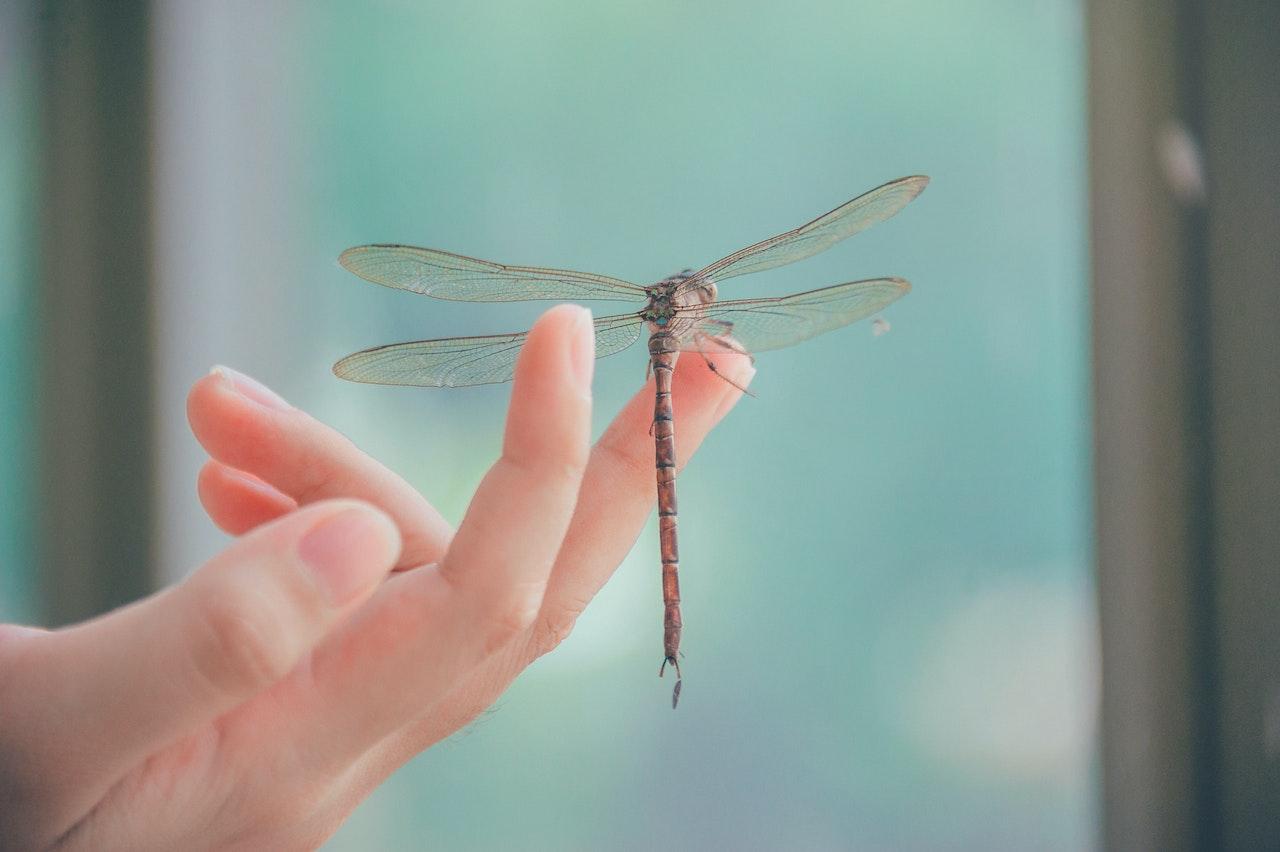
Folklore & Nature: Dragonflies
Blue-eyed Darner Dragonfly
In Scandinavia a dragonfly flying near you was thought to be weighing your soul for the devil and the devil is also connected to dragonflies in another way. One story from Romania recounts how after god let the devil run wild, he sent an army of angels, led by St. George to defeat the devil, but as they charged, the devil cast a spell on St. George’s horse, turning it into a dragonfly.
Another horse story comes from Germany and is about a princess who was too wild and led a selfish life racing around on her horse until one day she treated a little man poorly and rode away. But as she raced off on her horse, the man cursed after her “may you always be joined to your horse as one!” and they transformed into a dragonfly, called Hatzpferd.
Like butterflies, dragonflies have also been linked to regeneration, immortality and rebirth. In China the dragonfly symbolizes summer, but also instability. To the Zuni Native Americans, dragonflies possessed supernatural powers and feature in the legend ‘The Origin of the Dragonfly and of the Corn Priests’ where young siblings are rescued and blessed by the Maidens of the Corn. When the children become great leaders, the boy makes a corn-being on the advice of the Corn Priests calling it dragonfly, and so the dragonfly and corn were always connected. In Navajo legends, the first world was inhabited by Insect People, some of whom were dragonflies.
The Mystical Beliefs Behind Dragonflies and Death
For centuries, the human imagination has been captivated by fascinating creatures known as dragonflies.
One of the symbolic meanings often associated with them is death.
Although it may seem confusing at first, the link between dragonflies and death is based on a complicated web of historical, cultural, and spiritual beliefs – and here we’ll explore these meanings that have made dragonflies mysterious beings.
Dragonflies were believed to carry the souls of the deceased to the afterlife in some ancient cultures due to ancient beliefs and myths – and there have been quite complex myths surrounding these creatures around the world.
Red dragonflies are believed to be the spirits of the dead visiting their loved ones in Japanese folklore. It doesn’t necessarily have a negative connotation but it can certainly come as quite a surprise to learn that an ancestor is visiting you even if it is in the form of a dragonfly.
In Japanese culture, it is also a:
Symbol of courage: In Japanese culture, the dragonfly is often associated with courage. Due to its agile flight and predatory nature, it is considered a symbol of courage and strength.
Symbol of good fortune: The dragonfly is believed to bring good luck, prosperity, and harmony. It is a symbol of good fortune and prosperity. A sense of peace and prosperity is often brought by the positive sign that is frequently seen in traditional Japanese art and design.
Dragonflies are viewed as messengers between the living and the spirit world in Native American mythology, similar to how they are seen in other cultures. They are also considered a:
- Symbol of transformation: The dragonfly is a symbol of transformation and renewal because it undergoes a fascinating metamorphosis from a water-dwelling nymph to an airborne adult. The renewal of life and immortality of the soul is also represented by this transformation, which is frequently linked to the presence and communication of ancestors.
- Connection to dreams and illusions: The iridescent wings and bodies of these creatures are often viewed as a symbol of life’s illusions and the importance of seeing beyond them to truly comprehend.
They are associated with the winding journey of self-discovery, much like the flight pattern of a dragonfly. Dragonflies are believed to be the souls of the deceased dreaming of the life they once had in some tribes. - Symbol of happiness: Some Native American tribes consider the dragonfly as a symbol of happiness, speed, and purity, representing new beginnings.
The symbolism of the dragonfly varies greatly in European folklore and often differs from its positive associations in other cultures. Some noteworthy interpretations are the following:
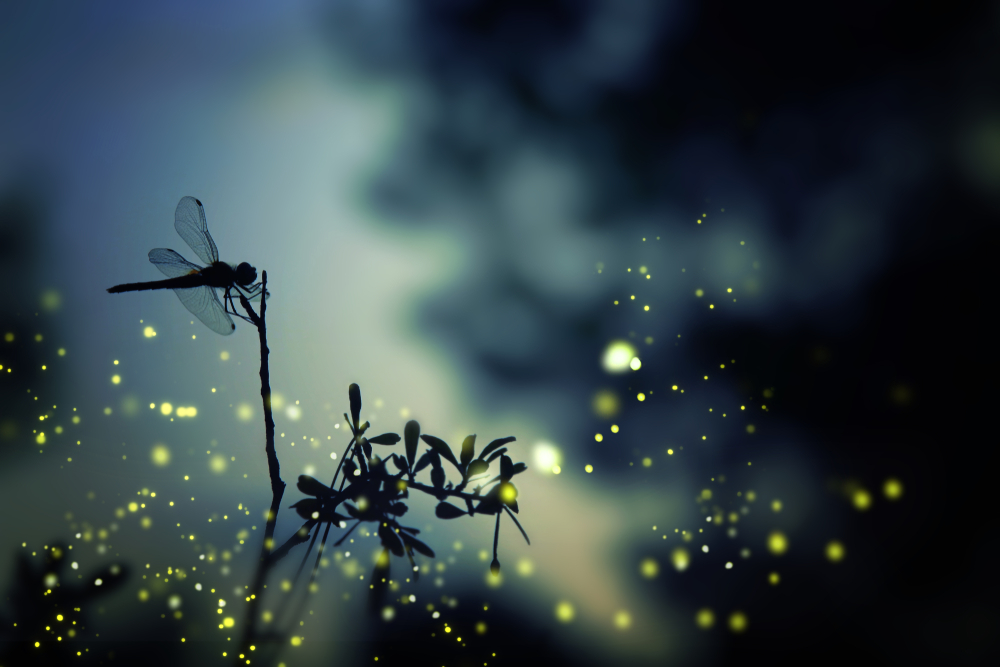
- Association with the devil (and death): Dragonflies have historically been associated with the devil or evil spirits in many parts of Europe, particularly Scandinavia and Eastern Europe. In these regions, dragonflies are sometimes called devil’s darning needles or devil’s horses. Dragonflies were believed to sew up the eyes, ears, or mouths of sleeping children, particularly those who had misbehaved.
- Connection to the fairy world: Dragonflies are frequently linked with fairies, especially in Celtic regions of Europe. A link between the human world and the magical realm of the fairies is seen in them. Dragonflies are sometimes viewed as the mounts of fairies in folklore and are regarded as signs of fairy encounters.
Like certain Native American cultures, Chinese culture also regards the dragonfly as a creature of the dream world, connecting it to dreams and illusions. Calling for a deeper understanding of the self and the universe, it symbolizes the illusion of time and the fleeting nature of life.
However, they are also a symbol of change and death due to their changing nature and dramatic transformation to become a flying adult during their life cycle.
This insect has generated different myths not only in the past. Today, it is still part of mystical beliefs that relate dragonflies to magical beings – and a connection between the world of the living and the dead. Some of the current beliefs are the following:
- Visit from a deceased person: It is believed that dragonflies are connected to the spiritual world. A deceased loved one or a guardian angel is believed to be indicated by these small symbols. These serve as a visual reminder that your loved ones are nearby, much like a visit from a cardinal.
Even though our departed loved ones may no longer be with us on this earth, we can still sense their vigilant gaze. For those who are grieving, this is a significant source of comfort.
- Good luck: Dragonflies are considered a good luck charm in many religions and cultures. A small symbol of beauty, grace, and change, they are. They are always welcome as small, graceful creatures. The reason for this is probably that dragonflies eat mosquitoes. They do humans a favor by limiting the spread of disease and unwanted pests by consuming a well-known nuisance.
- Dragonflies symbolize the transience of life: Due to their unique biological characteristics and brief adult lifespan, dragonflies can be powerful symbols of the fleeting nature of life. Appreciating the present moment is encouraged by their ephemeral existence, reminding us of the transitory nature of our own lives.
Dragonflies remain a mystical connection to the afterlife
Currently, dragonflies continue to be a symbol of connection between our world and the afterlife, which is why for many people they have a profound value and can generate a feeling of joy and comfort in knowing that their loved ones continue to communicate with them.
So, finding a dragonfly (depending on your beliefs) can be a truly meaningful experience that gives you the answers you need in life.
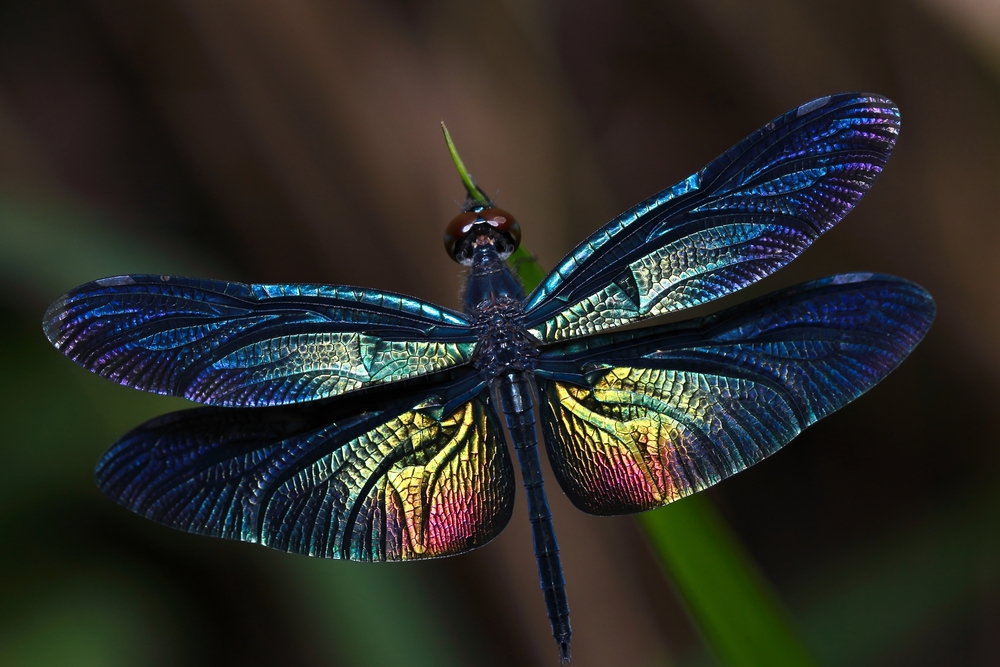
Folklore
Attitudes towards odonates vary enormously from country to country, the Far Eastern perception differing markedly from that of the European. The folklore of many western countries holds that they are snakes’ companions. In America, a superstition was that dragonflies were capable of stitching the mouths, and sometimes the eyes and ears, of lying children, scolding women and cursing men. Satan is often said to have sent dragonflies into the world to cause mischief; in Italy and among the Dakota Indians, the insects are known as witches’ animals. If the witch is the devil’s creature then, by association, so are dragonflies. This is in sharp contrast to the Orient, where they were never considered evil.
To the Chinese, they are an emblem of summer – but also a symbol of feebleness and instability. In Japan, they are revered and respected, being symbolic of happiness, strength, courage and success. To the Japanese, the dragonfly (Tombo) is an important cultural symbol and was believed to be the spirit of the rice plant and a harbinger of rich harvests. Akitsushmi, which means Dragonfly Island, is an alternative name for Japan.
The Dragonfly in Folklore: Good Luck Symbol and Weigher of Souls
There’s something magical about seeing a dragonfly darting between the reeds on a spring day. With their jewel-like colours and ability to fly backward, they’re quite the aerial specialist.
One of the Romanian tales has the Devil trying to cross a lake. A fisherman refuses to carry him in his boat, so the Devil adopts the form of a winged insect to fly across. He takes the form we now know as a dragonfly, and hence dragonflies exist.
In Europe, dragonflies often end up associated with the devil or black magic. Some of these negative associations do appear in American folklore, implying people took the beliefs with them when they emigrated to the New World. But the equal number of positive tales about dragonflies in America suggest an ability for people to create their own myths and beliefs.


